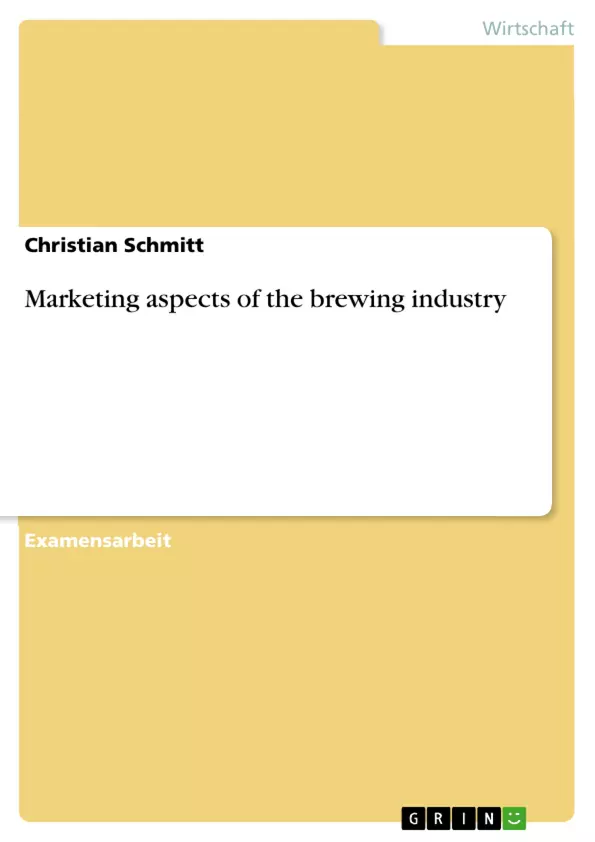Anheuser-Busch has to rethink its current strategy and to focus on its core competence: brewing and marketing of beer. A strategic realignment acquires a disinvestment in the business units with low strategic fit, e.g. the theme park or the agriculture division. The integration strategy has to be ended. The money tied up there and additional funds by investors have to be used to acquire other breweries, especially in the emerging markets. At the same time, Anheuser-Busch should increase its interest in Grupo Modelo, to counteract demographic changes in its home market, the United States. Moreover, the brewery has to invest heavily in research and development, a key element for future success in the brewing industry. New beer and beer-mixed categories offer an opportunity for high profits, as new consumers feel attracted by these products. Besides all these changes, Anheuser-Busch should not take away too much attention from its home market and defend the leading market position. Thereby, the brand is the key element to success in the beer industry. Anheuser-Busch has to assure that it obtains the current brand reputation. The same applies to possible new acquisitions. The brewing business is quite a lucrative industry for macro-breweries like Anheuser-Busch. The overall pressure caused by the industry forces is moderate to low. The big market participants have only to be aware of substitute products, rivalry and, to a certain degree, of new entrants. Substitute products, like wine or other liquors, are becoming more and more popular, putting pressure on the beer market. Anheuser-Busch has to react by introducing new products and has to help that beer keeps a fashionable image. The rivalry is only a problem in the mature markets, whereas the pressure is low in emerging markets due to the market growth.
Inhaltsverzeichnis
- Executive Summary
- Brewing Industry Background
- Market Overview
- Current Conditions
- United States of America
- Germany
- Worldwide
- Companies
- InBev
- "Target Company": Anheuser-Busch
- Company comparison
- Marketing Mix
- Product
- Price
- Place
- Promotion
- Environment
- Legislation and regulations
- Societal values and lifestyle
- General economic conditions
- Industry analysis
- Competitive Rivalry within an Industry
- Threat of New Entrants
- Threat of Substitute Products
- Bargain Power of Suppliers
- Bargain Power of Customers
- Industry forces summery
- Company Analysis: Anheuser-Busch
- Strength
- Weaknesses
- Threats
- Opportunities
- Analytical comparison of InBev and Anheuser-Busch
- Driving Forces in the Industry
- Anheuser-Busch's Latest Actions
- Recommendations for Anheuser-Busch
- References
Zielsetzung und Themenschwerpunkte
Dieser Text befasst sich mit den Marketingaspekten der Brauindustrie, wobei der Fokus auf dem Unternehmen Anheuser-Busch liegt. Die Arbeit untersucht die aktuelle Marktposition des Unternehmens, analysiert die relevanten Branchentrends und identifiziert strategische Handlungsmöglichkeiten.
- Analyse der Brauindustrie und ihrer wichtigsten Akteure
- Bewertung der Marketingstrategie von Anheuser-Busch im Vergleich zu anderen Brauereien
- Identifizierung von Chancen und Risiken für Anheuser-Busch im aktuellen Marktumfeld
- Entwicklung von Handlungsempfehlungen für Anheuser-Busch, um seine Marktposition zu stärken und zukünftiges Wachstum zu sichern
- Bewertung der Bedeutung von Markenimage und Innovation in der Brauindustrie
Zusammenfassung der Kapitel
Die ersten Kapitel bieten einen Überblick über die Brauindustrie, einschließlich ihrer historischen Entwicklung, des aktuellen Marktumfelds und der wichtigsten Unternehmen. Es wird auf die globale Bedeutung des Biermarktes eingegangen und die spezifischen Bedingungen in den Vereinigten Staaten, Deutschland und anderen Ländern beleuchtet.
Anschließend wird die Marketingstrategie von Anheuser-Busch im Detail analysiert. Dabei werden die einzelnen Elemente des Marketing-Mix (Produkt, Preis, Platz, Promotion) betrachtet und die strategischen Entscheidungen des Unternehmens beleuchtet.
Weitere Kapitel befassen sich mit den Einflussfaktoren auf die Brauindustrie, wie z. B. gesetzliche Rahmenbedingungen, gesellschaftliche Werte und allgemeine Wirtschaftsbedingungen. Die Arbeit analysiert die Wettbewerbsintensität innerhalb der Branche und identifiziert die wichtigsten Herausforderungen für Anheuser-Busch.
Schlüsselwörter
Brauindustrie, Anheuser-Busch, Marketingstrategie, Marktforschung, Wettbewerbsanalyse, Branchentrends, Konsumentenverhalten, Markenimage, Innovation, Wachstumspotenzial.
- Arbeit zitieren
- Christian Schmitt (Autor:in), 2007, Marketing aspects of the brewing industry, München, GRIN Verlag, https://www.grin.com/document/167372



